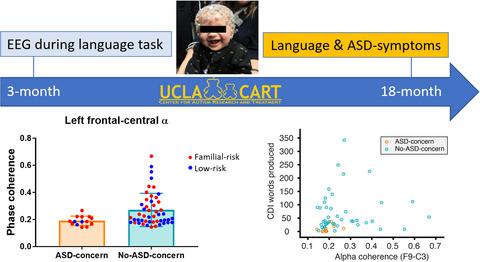当前位置:
X-MOL 学术
›
Eur. J. Nerosci.
›
论文详情
Our official English website, www.x-mol.net, welcomes your feedback! (Note: you will need to create a separate account there.)
Functional connectivity during language processing in 3‐month‐old infants at familial risk for autism spectrum disorder
European Journal of Neroscience ( IF 3.4 ) Pub Date : 2020-10-12 , DOI: 10.1111/ejn.15005 Xuan A Tran 1 , Nicole McDonald 1 , Abigail Dickinson 1 , Aaron Scheffler 1 , Joel Frohlich 1 , Andrew Marin 1 , Christopher Kure Liu 1 , Erin Nosco 1 , Damla Şentürk 1 , Mirella Dapretto 1 , Shafali Spurling Jeste 1
European Journal of Neroscience ( IF 3.4 ) Pub Date : 2020-10-12 , DOI: 10.1111/ejn.15005 Xuan A Tran 1 , Nicole McDonald 1 , Abigail Dickinson 1 , Aaron Scheffler 1 , Joel Frohlich 1 , Andrew Marin 1 , Christopher Kure Liu 1 , Erin Nosco 1 , Damla Şentürk 1 , Mirella Dapretto 1 , Shafali Spurling Jeste 1
Affiliation

|
Auditory statistical learning (ASL) plays a role in language development and may lay a foundation for later social communication impairment. As part of a longitudinal study of infant siblings, we asked whether electroencephalography (EEG) measures of connectivity during ASL at 3 months of age‐differentiated infants who showed signs of autism spectrum disorder (ASD) at age 18 months. We measured spectral power and phase coherence in the theta (4–6 Hz) and alpha (6–12 Hz) frequency bands within putative language networks. Infants were divided into ASD‐concern (n = 14) and No‐ASD‐concern (n = 49) outcome groups based on their ASD symptoms at 18 months, measured using the Autism Diagnostic Observation Scale Toddler Module. Using permutation testing, we identified a trend toward reduced left fronto‐central phase coherence at the electrode pair F9‐C3 in both theta and alpha frequency bands in infants who later showed ASD symptoms at 18 months. Across outcome groups, alpha coherence at 3 months correlated with greater word production at 18 months on the MacArthur‐Bates Communicative Development Inventory. This study introduces signal processing and analytic tools that account for the challenges inherent in infant EEG studies, such as short duration of recordings, considerable movement artifact, and variable volume conduction. Our results indicate that connectivity, as measured by phase coherence during 2.5 min of ASL, can be quantified as early as 3 months and suggest that early alternations in connectivity may serve as markers of resilience for neurodevelopmental impairments.
中文翻译:

具有自闭症谱系障碍家族风险的3个月大婴儿的语言处理过程中的功能连接
听觉统计学习(ASL)在语言发展中发挥作用,并可能为以后的社会沟通障碍奠定基础。作为对婴儿兄弟姐妹的纵向研究的一部分,我们询问是否在3个月大但有自闭症谱系障碍(ASD)迹象的3个月婴儿中进行ASL期间的脑电图(EEG)连通性测量。我们在假定语言网络内的theta(4–6 Hz)和alpha(6–12 Hz)频带中测量了频谱功率和相位相干性。婴儿分为关注ASD(n = 14)和不关注ASD(n = 49)基于18个月时的ASD症状的结局组,使用自闭症诊断观察量表蹒跚学步模块进行测量。通过排列测试,我们发现了在θ18和α频段的电极对F9-C3的左额中央相干相干性下降的趋势,这些婴儿后来在18个月出现ASD症状。在整个结果组中,MacArthur-Bates交流发展清单上3个月的alpha连贯性与18个月时的更多单词产生相关。这项研究引入了信号处理和分析工具,这些工具可以解决婴儿脑电图研究固有的挑战,例如录音时间短,运动伪影大和音量传导可变。我们的结果表明,根据ASL 2.5分钟内的相干性来衡量连通性,
更新日期:2020-10-12
中文翻译:

具有自闭症谱系障碍家族风险的3个月大婴儿的语言处理过程中的功能连接
听觉统计学习(ASL)在语言发展中发挥作用,并可能为以后的社会沟通障碍奠定基础。作为对婴儿兄弟姐妹的纵向研究的一部分,我们询问是否在3个月大但有自闭症谱系障碍(ASD)迹象的3个月婴儿中进行ASL期间的脑电图(EEG)连通性测量。我们在假定语言网络内的theta(4–6 Hz)和alpha(6–12 Hz)频带中测量了频谱功率和相位相干性。婴儿分为关注ASD(n = 14)和不关注ASD(n = 49)基于18个月时的ASD症状的结局组,使用自闭症诊断观察量表蹒跚学步模块进行测量。通过排列测试,我们发现了在θ18和α频段的电极对F9-C3的左额中央相干相干性下降的趋势,这些婴儿后来在18个月出现ASD症状。在整个结果组中,MacArthur-Bates交流发展清单上3个月的alpha连贯性与18个月时的更多单词产生相关。这项研究引入了信号处理和分析工具,这些工具可以解决婴儿脑电图研究固有的挑战,例如录音时间短,运动伪影大和音量传导可变。我们的结果表明,根据ASL 2.5分钟内的相干性来衡量连通性,



























 京公网安备 11010802027423号
京公网安备 11010802027423号